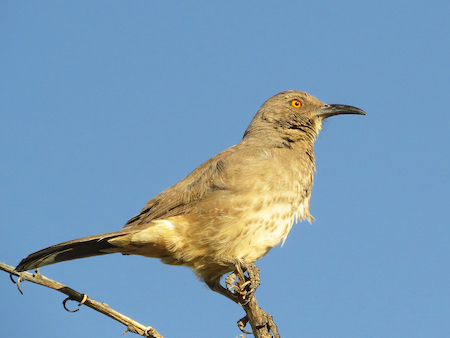 Curve-billed thrashers are common in Silver City. They tend to hang-out in cholla cacti. Their melodic songs are common this time of year. Photo by Don Faulkner via a Creative Commons Attribution-Share Alike 2.0 Generic license.
Curve-billed thrashers are common in Silver City. They tend to hang-out in cholla cacti. Their melodic songs are common this time of year. Photo by Don Faulkner via a Creative Commons Attribution-Share Alike 2.0 Generic license.
The 21st Great Backyard Bird Count (GBBC) will take place February 16 to 19, 2018. The GBBC is free, fun and easy. It is easy to participate, just count the birds you see for at least 15 minutes on one or more days of the count. You can count for longer and you can count on each of the three days. You enter each count online at birdcount.org. The data is then linked to eBird.org, which collects bird observations globally every day of the year and can be used to see what birds people are reporting here or any other location worldwide.
You don’t have to have a bird feeder. There are probably birds in your yard if you take the time to look. Perhaps you have curve-billed thrashers in your cholla cactus. How many do you see in a 15-minute time period? Are you seeing any robins? What about juncos, house finches or ravens? There are over 300 species of birds that have been reported in Grant County but the GBBC seeks to learn which ones and how many are here right now
The information that is collected is important because bird populations are always shifting and changing. Not sure what birds you are seeing? There are several online tools to help at Audubon.org. Try the free bird guide at Audubon.org or download the free Audubon app for either iOS or android to help identify the birds of North America
This global event provides an opportunity for bird enthusiasts to contribute important bird population data that help scientists see changes over the past 21 years. This is a great example of how ordinary citizens can contribute to scientific discoveries.The GBBC is a joint project of the Cornell Lab of Ornithology and the National Audubon Society with partner, Bird Studies Canada, and is made possible in part by founding sponsor Wild Birds Unlimited.
This GBBC is particularly notable this year because it coincides with publicity for the Year of the Bird, a 12-month celebration of birds to raise awareness of how people can help birds by taking simple actions each month. Year of the Bird is a joint project of National Geographic, the National Audubon Society, the Cornell Lab of Ornithology, BirdLife International, and more than 100 participating organizations. Learn more about Year of the Bird at www.birdyourworld.org.
For more information about the GBBC, go to the official website birdcount.org.